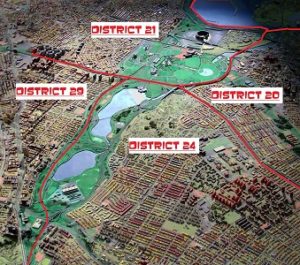
Flushing Meadow Corona Park with District Overlay.
Council Member’s lawsuit over non-profit park alliance’s structure and funding continues after the City attempted to squash the claim. On February 16, 2017, the New York Supreme Court denied the City’s motion to dismiss a suit against the Mayor regarding the Flushing Meadows Corona Park Alliance.
In July 2016, Council Member Rory Lancman brought a suit against both the Mayor and the Alliance in New York State Supreme Court. In the complaint, Lancman alleged that the composition of the Alliance’s Board of Directors violated the City’s Administrative Code. Specifically, Lancman argued that Administrative Code Section 18-137(b) requires every licensed non-profit conservancy entity for a park to have local representation appointed to the board of directors by the council member of each district that the park is located within. Lancman also alleged that the Alliance’s funding structure violated the City Charter. Section 109 of the City Charter reads, “All revenues of the city . . . not required by law to be paid into any other fund or account shall be paid into a fund to be termed the ‘general fund.’” Lancman alleged that the USTA’s initial and annual payments violated this section of the Charter because the payments went directly to the City Parks Foundation and then the Alliance instead of the City’s general fund, which would then be subject to the Charter’s budget process.Lancman argues that the right to appoint a member to the board was a reward given to Julissa Ferreras-Copeland from the de Blasio administration for negotiating the USTA land-use deal and for being a political ally of the Mayor. As evidence, Lancman points out that the other three council members whose districts also overlap the park have no such appointment authority: himself, Council Member Peter Koo, and Council Member Karen Koslowitz. “Flushing Meadows Corona Park belongs to the public,” Lancman wrote in a published opinion. “Instead, the de Blasio administration has created yet another shadowy quasi-governmental entity to evade public scrutiny and reward its political allies with governmental favors. It’s unacceptable, it’s illegal, and it has to stop.”
Declaratory judgments, like the lawsuit brought by Lancman, have no specified Statute of Limitations, instead it is the duty of the court to determine which time limitations apply. In its motion to dismiss, the City argued that the claim was time barred by the statute of limitations on an Article 78 petition—four months from the injury occurring. Lancman, on the other hand, argued that the six-year catch-all statute of limitations would apply, but that it wouldn’t matter because the injury was being repeated daily by the structure and funding of the Alliance.
Judge Arlene P. Bluth agreed with Lancman, ruling that the allegation that the Alliance’s structure and funding scheme, if found to be true, “constitutes a continuing violation for purposes of the statute of limitations.” Judge Bluth ordered the parties to appear for a preliminary conference on April 4, 2017.
In October 2016, Council Member Lancman proffered Introduction 1302-2016 to the City Council. The bill does not address the funding structure complaint raised by Lancman in the lawsuit. The bill does, however, explicitly require that every councilmember with a park in their district be entitled to appoint a board member to every non-profit with a conservancy agreement with the City to run the park. The bill defines a conservancy agreement as a written authorization allowing a nonprofit to (1) hire or provide funds to hire any person to work in a City park, (2) raise, accept, or administer public funds to improve or maintain a park, or (3) raise, accept or administer private funds, derived in any way from the use of a park, to improve or maintain that park.
The bill was referred to the Committee on Parks and Recreation for consideration where it has remained. If passed, parts of Lancman’s suit against the Mayor and the Alliance would be resolved.
By: Jonathon Sizemore (Jonathon is the CityLaw Fellow and a New York Law School Graduate, Class of 2016).

